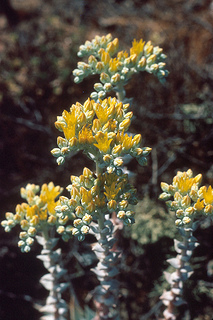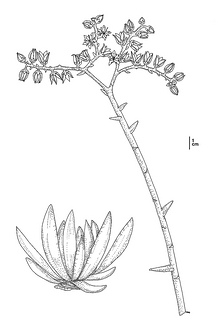(Dudleya traskiae)
 Dudleya traskiae. Photo © California Native Plant Society 1985.
Dudleya traskiae. Photo © California Native Plant Society 1985.
 Dudleya traskiae. CDFW illustration by Mary Ann Showers. (Click to enlarge)
Dudleya traskiae. CDFW illustration by Mary Ann Showers. (Click to enlarge)
Santa Barbara Island dudleya is a California endangered plant species, which means that killing or possessing plants collected from the wild is prohibited by the California Endangered Species Act (CESA). The species is also listed as endangered under the federal Endangered Species Act. Santa Barbara Island dudleya is a perennial herb found on Santa Barbara Island. It has bright yellow flowers with red veins that stem from basal rosettes. The flowers typically bloom from April to May, and sometimes as late as July. The flowers generally stand about twenty to thirty centimeters tall. Currently, there are eleven sites on Santa Barbara Island that support Santa Barbara Island dudleya. Because of their close proximity to each other, the California Natural Diversity Database maps these eleven sites as three occurrences, and at the time of this webpage posting, all three occurrences are presumed to still exist.
Santa Barbara Island dudleya is endemic to Santa Barbara Island, meaning its range has always been restricted to the island. Santa Barbara Island is a 652-acre island located about 38 miles offshore from the mainland. It is a part of Channel Islands National Park, which was designated as a National Park in 1980. Its topography is comprised of rugged cliffs, the tallest of which is Signal Peak, which is 635 feet above sea level. The first observations of Santa Barbara Island dudleya were made after nonnative herbivores were introduced to the island, so while it is believed that the plant was more widespread before settlers colonized the island, this cannot be confirmed. The introduction of goats, cats, sheep, New Zealand red rabbits, and Belgian hares, as well as the cultivation of oats, barley, and potatoes all severely impacted the ecology of Santa Barbara Island.
The National Park Service has since eradicated hares and rabbits from the island, and has undertaken many other management actions to restore the island’s natural ecology and remove external impacts. Following hare and rabbit eradication, populations of Santa Barbara Island dudleya became stable, with some beginning to increase. Additionally, National Park staff have completed three outplanting efforts. Population numbers are still low, and most occurrences demonstrated low recruitment for many years, but recent monitoring efforts have revealed that some populations are beginning to show increased recruitment and appear to be stable. Additional activities that have been implemented include restricting public access to the island, removing iceplant, and researching the demographics of Santa Barbara Island dudleya.
Current threats to Santa Barbara Island dudleya include residual impacts from previous landscape disturbances, such as the establishment of nonnative plants, and soil erosion. Additionally, a recent expansion of the brown pelican population and roosting habitat may have negatively affected Santa Barbara Island dudleya through trampling. Other threats include low reproduction rates, climate change, and random natural events. In order to ensure the continued existence of the species, the threat posed by brown pelicans should be assessed and addressed, if necessary. Efforts to expand existing Santa Barbara Island dudleya populations and establish new colonies should be continued. Additionally, seed should be collected and stored from colonies not currently represented in seed banks, and new surveys should be conducted, especially of locations that have not been surveyed in recent years.
CDFW participated in a study of the Status of the Endangered and Rare Plants on Santa Barbara Island, Channel Islands National Park (PDF), which included reporting on Santa Barbara Island dudleya, with support via the Cooperative Endangered Species Conservation Fund.
CDFW may issue permits for Santa Barbara Island dudleya pursuant to CESA, and you can learn more about the California laws protecting Santa Barbara Island dudleya and other California native plants. Populations of Santa Barbara Island dudleya occur in CDFW’s South Coast Region. More information on Santa Barbara Island dudleya is also available from the U.S. Fish and Wildlife Service Species Profile for Santa Barbara Island Dudleya.
Updated 01/14/2014